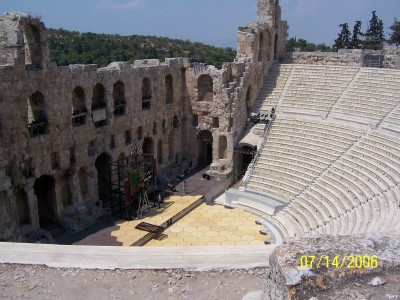|
The content on this website is maintained by
Robert Myallis, pastor at Zion's Lutheran Church, of Jonestown, PA.
The photos were taken by
Emily Myallis, a diaconal minister in the ELCA who also serves at Zion's Lutheran.
This website and travel to
Greece was made possible by a grant from the
Fund for Theological Education,
which provides grants to assist the education and formation of
Christian leaders from numerous denominations.
Bible quotes are taken from the New
Revised Standard Version, unless cites otherwise.
The above photo of Greece comes from
NASA; The icon of Saint Paul comes from George Mitrevski's website. |
 |
|
Odeion

The Odeion was built in the 2nd century
AD with the money of Herodes Atticus. Built to house musical
performances, Herodes dedicated it to his dead wife. Herodes, an
orator and teacher, actual taught the stoic emperor Marcus
Aurelius.
How is the Odeion significant for
understanding the world of Paul?
Most of the earlier monuments in Athens are dedicated to gods.
However, this wealthy benefactor named this theater after
himself. The tradition of wealthy members of society building
things and then declaring themselves benefactor does go back
nearly a millennia earlier in Greece. In general, Greek
and Romans liked to serve as patrons of art and have their
patronage displayed. As one plaque at the national archeological
museum indicated people funded art in order to display their
“power, personal character and ambitions.”
(It also serves as a reminder that even in the days of marriage
serving as a family contract, men and women could find love!)
Paul will eventually remix this idea of benefaction. See
The dedications at the Oracle of Delphi
source:
info on benefaction:
placard at National Archeological Museum placard, July 2006.
|
|



